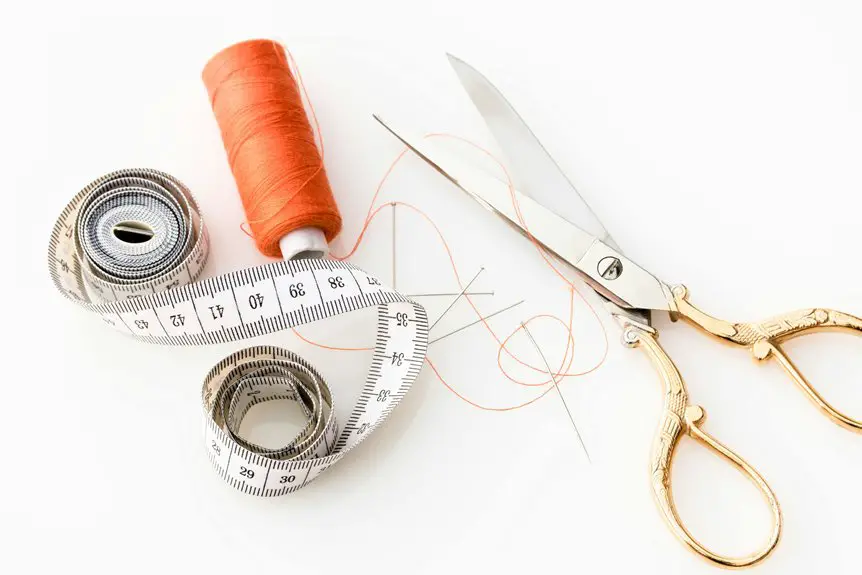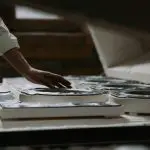When quilting batik fabric, you’ll want a sharp needle sized between 70/10 and 80/12. This size is perfect to pierce the tightly woven cotton without causing snags or puckering. Using a universal or quilting needle with strong materials like stainless steel guarantees clean, even stitches through the wax-treated fabric. Picking the right needle prevents damage and helps your machine run smoothly. If you want to get the best results and avoid common pitfalls, keep exploring how to handle batik in quilting projects.
Table of Contents
Key Takeaways
- Use needle sizes between 70/10 and 80/12 for quilting batik fabric to ensure clean, precise stitching without fabric damage.
- Choose sharp or Microtex needles for piercing tightly woven batik cotton smoothly.
- Universal or quilting needles made of stainless steel or titanium work best for multiple batik fabric layers.
- Test stitching on batik fabric scraps to confirm needle compatibility and adjust machine tension accordingly.
- Replace needles after 6-8 hours of use to maintain stitch quality and prevent fabric snags or skipped stitches.
Understanding the Characteristics of Batik Fabric
Although batik fabric appears delicate, it’s actually quite sturdy due to its wax-resist dyeing process. When you handle batik, you’ll notice its slightly stiff texture from the wax, which helps maintain the fabric’s shape.
The dye creates vibrant, often intricate patterns, but the fabric itself remains breathable and flexible. Since batik is usually made from cotton or silk, you’ll find it has a smooth surface with a slight sheen.
This combination means your quilting needle needs to pierce through without snagging or causing damage. Understanding these characteristics helps you appreciate why batik demands specific care and tools when quilting.
Paying attention to its unique texture and sturdiness guarantees your finished project looks beautiful and lasts long.
Why Needle Size Matters in Quilting
Because the needle is the tool that directly interacts with your fabric, choosing the right size is crucial to achieving clean stitches and preventing damage.
Using a needle that’s too large can cause noticeable holes or weaken the fabric fibers, while one too small might bend or break frequently.
Here’s why needle size matters in quilting:
- Guarantees stitch quality with even, consistent tension.
- Prevents fabric distortion or puckering around stitches.
- Minimizes wear and tear, extending your quilt’s lifespan.
- Improves sewing machine performance by reducing skipped stitches or jams.
Recommended Needle Sizes for Batik Quilting
When working with batik fabric, choosing the right needle type is key to smooth stitching.
You’ll want to match needle size to the fabric’s thickness to avoid puckering or skipped stitches.
Let’s explore the ideal needle sizes that work best for batik quilting.
Needle Types for Batik
Choosing the right needle type plays a crucial role in quilting batik fabric, as it affects both the stitching quality and the fabric’s integrity.
You’ll want needles that glide smoothly without damaging the delicate fibers or disrupting the fabric’s unique dye patterns. Here are four common needle types to take into account for batik quilting:
- Universal Needles – Versatile and generally suitable for batiks, providing a balanced stitch.
- Sharp (or Microtex) Needles – Ideal for tightly woven batiks, as they pierce cleanly without causing snags.
- Quilting Needles – Designed specifically for quilting layers, they help maintain fabric strength.
- Topstitch Needles – Perfect if you want visible stitches, offering precise and even stitching on batik fabric.
Choosing among these depends on your batik’s weave and project needs.
Optimal Needle Size Guide
Selecting the right needle size greatly impacts your batik quilting results, as it secures clean stitches without damaging the fabric.
For batik quilting, you’ll want to use needles sized between 70/10 and 80/12. These sizes are sharp enough to pierce the tightly woven cotton without causing pulls or snags. If you choose a needle too large, you risk leaving noticeable holes; too small, and it may bend or break.
A universal or quilting needle in these sizes works best since they’re designed to handle multiple layers and dense fabrics like batik comfortably.
Always test on a fabric scrap first to verify smooth stitching. By sticking to 70/10 or 80/12, you’ll maintain the integrity of your batik while producing precise, durable quilt stitches.
Fabric Thickness Considerations
The needle size you pick depends largely on the thickness of your batik fabric layers. Thicker layers need a sturdier needle to penetrate smoothly without damaging the fabric.
Here’s a quick guide to help you choose:
- Single Layer Batik: Use a size 70/10 needle for delicate, thin fabrics to avoid puckering.
- Two Layers: Opt for size 80/12 needles for medium-weight batiks to guarantee balanced stitching.
- Three or More Layers: Choose size 90/14 or 100/16 needles to handle bulk without breaking.
- Quilting with Batik: A quilting needle in size 75/11 or 90/14 works well for layered batik quilts.
Adjust your needle size based on your fabric’s thickness to get smooth, even stitches every time.
Types of Needles Suitable for Batik Fabric
You’ll want to choose needles made from strong materials like stainless steel or titanium to handle batik fabric smoothly.
Picking the right size matters—usually between 70/10 and 80/12 works best for quilting batiks.
Plus, specialty needles designed for delicate or tightly woven fabrics can make your stitching cleaner and easier.
Needle Material Options
Although choosing the right needle size is important, the material of the needle also plays an essential role when working with batik fabric. The needle’s material affects its strength, sharpness, and how smoothly it glides through the fabric.
Here are four common needle materials you should consider:
- Steel – Durable and sharp, ideal for most quilting projects on batik.
- Titanium-coated – Offers extra strength and lasts longer, reducing needle changes.
- Nickel-plated – Smooth surface helps reduce friction but may wear out faster.
- Chrome-plated – Provides a balance between durability and smooth sewing action.
Choosing the right material guarantees your needle won’t damage the delicate batik fabric or cause skipped stitches during quilting.
Needle Size Recommendations
Selecting the right needle size plays an essential role in achieving smooth quilting on batik fabric. You’ll want needles that pierce easily without damaging the fabric’s intricate patterns. Generally, sizes between 70/10 and 80/12 work best. Smaller needles prevent puckering, while slightly larger ones handle multiple layers well. Below is a quick guide to help you choose:
| Needle Size | Recommended Use |
|---|---|
| 70/10 | Lightweight batiks, fine quilting |
| 75/11 | Medium-weight batik fabrics |
| 80/12 | Heavier batiks, multiple layers |
| 90/14 | Thick quilts with batting |
| 100/16 | Very heavy or dense fabrics |
Stick to these sizes to keep your stitches neat and your batik fabric intact.
Specialty Needles for Batik
Several specialty needles cater specifically to the unique texture and dye patterns of batik fabric.
Choosing the right needle guarantees your quilting goes smoothly without damaging the fabric or distorting its vibrant design. Here are four types to take into account:
- Microtex Needles – Their sharp points penetrate tightly woven batik fabric cleanly, preventing snags.
- Sharp Needles – Ideal for batik’s dense weave, they create precise stitches without puckering.
- Quilting Needles – Designed for layered fabrics, these needles handle batik quilts effectively.
- Topstitch Needles – Perfect if you want decorative stitching on batik, offering a larger eye for thicker threads.
Using these specialty needles helps maintain the integrity and beauty of your batik project, giving you professional results every time.
How to Choose the Right Needle for Your Project
When you start working with batik fabric, choosing the right needle can make all the difference in your quilting experience.
First, consider the fabric’s weight and texture; batiks are usually medium-weight, so a needle size between 75/11 and 90/14 works well. If your batik is tightly woven, opt for a finer needle to avoid damaging the fabric.
Also, think about your thread type—use a sharp needle for cotton threads and a microtex needle for delicate threads to guarantee smooth stitching.
Don’t forget your sewing machine’s capabilities; some machines handle smaller needles better.
Finally, test on a fabric scrap before starting your project. This way, you’ll know the needle glides through without causing puckering or skipped stitches, guaranteeing a flawless quilt.
Tips for Preventing Fabric Damage While Quilting
Choosing the right needle for your batik fabric helps protect it from damage, but there are more steps you can take to keep your fabric looking its best.
To prevent fabric damage while quilting, follow these tips:
- Use a sharp, fine needle suited for batik to minimize fiber stress.
- Adjust your machine’s tension settings to avoid puckering or pulling.
- Quilt slowly and steadily to maintain control and reduce fabric strain.
- Press seams gently with a warm iron to avoid scorching or distorting the fabric.
Troubleshooting Common Needle-Related Issues
If your stitching looks uneven or your fabric shows signs of damage, needle problems might be the cause.
Check if your needle is dull or bent; these can cause skipped stitches and fabric snags. Using the wrong needle size for your batik fabric can also create puckering or holes.
If you notice thread breakage, try switching to a finer needle to reduce tension. Make sure you’re using a quilting needle designed for tightly woven fabrics like batik.
Also, avoid needles that are too large, as they can leave noticeable holes. Regularly inspect your needle during quilting sessions and replace it at the first sign of wear.
Addressing these issues promptly will keep your quilting smooth and protect your delicate batik fabric.
Best Practices for Maintaining Your Quilting Needles
Keeping your quilting needles in top condition helps prevent the common issues mentioned earlier, like skipped stitches or fabric damage.
To maintain your needles effectively, follow these best practices:
- Replace needles regularly—after every 6-8 hours of sewing or when you notice dullness.
- Store needles in a dry, protective case to avoid bending or rust.
- Clean needles gently with a soft cloth to remove lint and fabric residue.
- Use the correct needle size and type for batik fabric to minimize wear and tear.
Frequently Asked Questions
Can I Use a Quilting Needle for Hand Sewing Batik Fabric?
Back in the day, you’d definitely want a quilting needle for hand sewing batik fabric. You’ll find it’s sharp enough to glide through layers without damaging the delicate wax patterns, making your stitching smooth and precise.
What Thread Type Works Best With Batik Fabric?
You’ll want to use 100% cotton thread with batik fabric since it matches the fabric’s natural fibers and allows for smooth stitching. Polyester blends might work but cotton thread guarantees durability and maintains the fabric’s authentic look.
How Does Humidity Affect Quilting Batik Fabric?
Humidity can make your batik fabric expand or contract, causing puckering or distortion while quilting. You’ll want to store it in a dry place and adjust tension or needle size to keep your stitches even and smooth.
Are There Specific Batting Materials Recommended for Batik Quilts?
Think of batting as the quilt’s heart, softly pulsing beneath vibrant batik petals. You’ll want cotton or bamboo batting—they breathe well and preserve batik’s colors, keeping your quilt cozy without stifling its lively, artistic spirit.
Can Batik Fabric Be Pre-Washed Before Quilting?
Yes, you can pre-wash batik fabric before quilting to remove excess dye and prevent bleeding. Just use cold water and a gentle detergent, then air dry to keep the colors vibrant and fabric stable.
- Does Chiffon Fabric Stink - July 15, 2025
- Does Chiffon Fabric Affect the Economy - July 15, 2025
- Does Cotton Fabric Have a Nap - July 15, 2025







